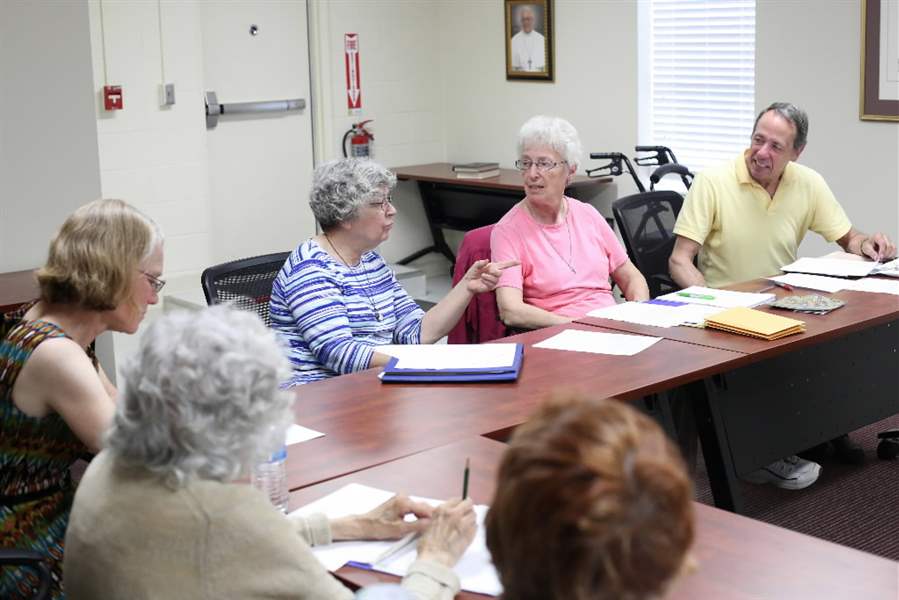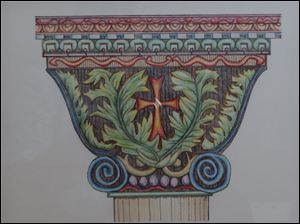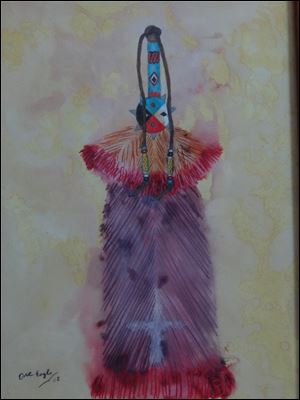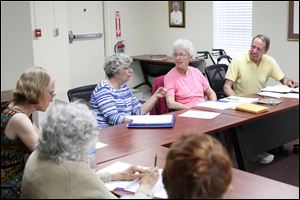
Artwork by death-row inmates goes on exhibit in Perrysburg
6/28/2015
Compassion outside board member Shelley Kotz of West Toledo, center left, speaks with other board members, including Louise Sarra of Rossford, left, Sister Pat Schnapp, center right, and chairman Fred Moor.
The Blade/Katie Rausch
Buy This Image

Venice Column Capital colored pencil by Paul Pavlock.
Imagine the serenity of painting a nodding sunflower on which a butterfly has lit, or a verdant pasture with contented Holsteins next to a stream.
Imagine solitary confinement on death row.
A bit jarring, those thoughts against each other. But that’s the reality of The Art of Conviction, an exhibit of 42 pieces by 29 men who await their executions. It is on display Wednesday through Aug. 15 in the second-floor hallway of Perrysburg’s Municipal Building.
Interestingly, the work includes no abstract art: perhaps because living on death row keeps one focused on reality, suggests Robin Baller, who put the exhibit together.
“They have nothing to gain or lose at this point in their life except to be the best person they can be for the rest of their life,” she says. “I’m hoping the people who walk down the hall [at the exhibit] will look at the artwork and see the restitution aspect of it.”
Adds Fred Moor: “An art show provides an audience for their work. It’s a way for them to give back.”

"One Eagle" watercolor by Milo Rose.
Should you purchase one of these freshly framed works, priced $25 to $125, your money will not be deposited in a commissary account for the artist to spend on smokes or ice cream. The restitution aspect is that the proceeds will be added to a scholarship fund for relatives of murder victims. The 26th such scholarship will be awarded in a few weeks to a Pennsylvania teenager, salutatorian of her class, who is heading to the Rochester Institute of Technology. Her father was stabbed to death five years ago.
The scholarships as well as the exhibit are outgrowths of an eight-page bimonthly newsletter called Compassion, sent to the 3,000 people on death row, U.S. senators and representatives, and subscribers. The newsletter began in 2001 in Perrysburg, and continues to be locally coordinated, designed, laid out, printed, and mailed for about $2,000 per issue, says Moor.
Death row numbers peaked in 2000 and 2001, with 3,593 and 3,581 inmates respectively, up from 134 in 1973. In 2015, 3,019 women and men await their fate. Ohio, one of 31 states with a death penalty, has 146 people, and Indiana has 14, according to the Death Penalty Information Center. Michigan, in 1846, was the first state to abolish the death penalty.
Why bother helping murderers live a more connected and fruitful life?
"Every one is a human being and has potential to do good in their lives," says Moor. "It's important they have the ability to try and redeem themselves in God's eyes.
"Most everybody I know has the potential to do good or to make changes in their lives, and death-row prisoners are not exempt from that."
●
Compassion has a two-month lead time because all communication is done by U.S. mail: prisoners send their hand-written articles, essays, or poems to a six-member "outside" board based in Perrysburg, which forwards them to editor George Wilkerson, on death row in North Carolina. "I'm very encouraged by his enthusiasm," says Moor. Wilkerson is the fourth editor; two have been executed.

Compassion outside board member Shelley Kotz of West Toledo, center left, speaks with other board members, including Louise Sarra of Rossford, left, Sister Pat Schnapp, center right, and chairman Fred Moor.
Wilkerson reads and selects 12-15 short pieces, edits them, and mails them back to Perrysburg; if additional changes are made, articles are mailed back to him, checked or tweaked, then returned to Perrysburg. Wilkerson is not allowed to have direct contact with the "inside" board of six prisoners, who send ideas for the newsletter to Perrysburg, from where they're forwarded to Wilkerson.
"It's pretty cumbersome but that's the way it is," says Moor, who owns Ken's Flower Shops.
●
Moor had long been interested in starting a prison newsletter and in 2000, he received a widespread mailing from a woman asking for just that. Her imprisoned brother had a friend who wanted to start a publication. The brother's friend was Carlos Sanders, now named Siddique Abdullah Hasan, who got the death sentence for his role in 1993's Lucasville prison riots, an 11-day siege that left one guard and nine inmates dead, at Southern Ohio Correctional Facility.
"Carlos had a great interest in starting something that would be different than other death-row newsletters," most of which rail against the death penalty, Moor says. "And part of our charter is we're not allowed to try and change the system by arguing against the death penalty."

"Black Butterfly" acrylic on canvas by Daniel Gwynn.
Inside the walls, Sanders/Hasan solicited articles from inmates. Outside the walls, Moor got immediate support from his late business partner, Ken Cappelletty, and Martha Baldoni, a former mayor of Perrysburg. The three, who shared a zeal for social justice, belonged to St. Rose Church in Perrysburg, which became a supporter as did Toledo's Catholic Diocese with a $5,000 annual donation. The first issue was in July, 2001. Topics have included tributes to mothers, gratitude, remorse, forgiveness from victim's relatives, loneliness, the good qualities of Nebraska's death row, and more.
The current issue's lead article is dedicated to a Toledo Notre Dame nun who wrote dozens of letters to prisoners monthly. Sister Mary Immaculee Heinl, who died in December at 92, encouraged her many correspondents to write for Compassion.
For Johnny Capistrano, Sister Mary was pen-pal and "Mother Teresa" for 18 years.
"She told me, ‘True love puts up with people who would be easier to give up on. This is the kind of love Christ modeled,' " wrote Capistrano, who lives in San Quentin State Prison. "You were a good steward of your life, spending it for the glory of God. I, in turn, will try to be a good steward of your death, spending what you left me for the glory of God."
Another "in memoriam" is by John Robinson, of Kansas, who also draws cartoons for the newsletter. "...She said, ‘remember me with a smile. Think of my passing this way: when I die, each person on death row will be gaining a lobbyist in heaven."
Says Martha Baldoni, a founding board member: "Many of the issues are extremely inspiring. I find it hard to believe that people who are locked up come up with such wonderful thoughts."
A longtime editor of Compassion said being on death row changes one's priorities: It encourages people to think about what they can give back, wrote Dennis Skillacorn. He also edited a moving 110-page book, Today's Choices Affect Tomorrow's Dreams, written by prisoners for young people to show "how even just one bad choice can change lives forever." Indeed, prisons are full of people who made one bad choice.
Compassion published 1,500 copies of the book and sent copies to juvenile detention facilities across the country.
Skillacorn was killed by lethal injection in 2009.
Another project in the works with Compassion's help is Windows on Death Row, an exhibition expected to open in October at the University of Southern California in Los Angeles. It will feature drawings about the death penalty by political cartoonists as well as cartoons by people on "the row."
"We have more than 60 works by inmates and 40 by professional cartoonists," including David Horsey, Pat Oliphant, and Jeff Danziger, says Anne-Fredrique Widmann, who's organizing the show.
"Art is a good starting point to have a conversation [about the death penalty], sometimes even better than words," says Widmann, who is married to Patrick Chappatte, cartoonist for the International New York Times and European media. The goal is to have the show travel the country and perhaps Europe, she says, with proceeds from the sale of cartoons going to Compassion's scholarship fund.
"The idea is not to put forward our opinions but to make a discussion happen," she says.
Learn more about Compassion at compassionondeathrow.net.
Contact Tahree Lane at tlane@theblade.com or 419-724-6075.